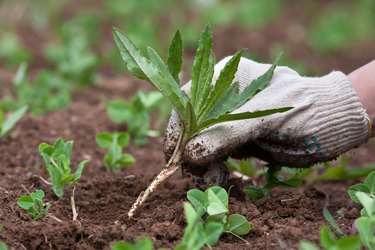
Weeds are the bane of every gardener, so you've probably found yourself wondering how to keep weeds and grass out of your vegetable gardens. Weeds seem to flourish with no care or support while the plants you want require attention almost daily. Weeds steal water, nutrients, sunlight and space from vegetable plants and jeopardize the viability of the garden. Gardeners must take defensive measures to stop and control weeds to enjoy a plentiful harvest of vegetables.
Weed Cultivation Method
Video of the Day
Cultivating or tilling the soil around vegetable plants in a garden is an effective, nontoxic method for weed and grass removal. A day or two after a soaking rain is the best time to hand-pull weeds. Wear waterproof garden gloves; you might also want a small stool to sit on. Reach your fingers into the soil and grab the main root ball of the weed before pulling. Twist as you pull to break the weed's roots.
Video of the Day
The use of a garden hoe or manual cultivator with a long handle trumps hand-pulling if weeding in the standing position is more comfortable. The tines of a cultivator loosen and turn soil, but the unwanted plants often require hand-pulling anyway.
While weeds typically grow roots near the surface of soil, some vegetable plants do as well. The closer the weed is to the vegetable plant, the greater the risk of damaging the vegetable plant's roots with cultivating tools. When working close to vegetable plants, pull weeds by hand.
Vegetable Garden Mulching Method
Distributing a thick 3- to 4-inch layer of mulching materials around vegetable plants in your garden discourages the growth of weeds and unwanted grass. Mulch blocks the sun so new seeds cannot germinate. When spreading mulch, keep the material 2 to 3 inches away from the stems of the plants.
Keep in mind mulch moderates ground temperatures. Inorganic mulch materials such as plastic sheeting, old carpet or weed-blocking fabric can warm soil. Warm soil benefits seeds undergoing germination or newly transplanted seedlings. However, when summer's heat arrives, organic mulch materials excel at cooling soil. Organic sources of mulch include mature compost, shredded wood, pecan shells, wood bark, grass clippings, straw, shredded leaves and newspaper. Sawdust is a poor choice for mulch as the bacteria needed to break it down steals nitrogen from the soil and garden plants.
Vinegar Weed Killer Method
Weeds cannot stand up against a soaking spray of vinegar. Vinegar contains acetic acid that lowers the pH to an intolerable level. However, vinegar is a non-selective weed killer, which means it'll kill any plant it comes into contact with. Use with caution around your vegetable plants as the vinegar mixture can harm them, too.
To make the solution, mix 1 gallon of white vinegar with 1 ounce of liquid dish soap to create a DIY weed killer. Stir until thoroughly mixed. Pour the mixture into the spray bottle.
Spray vinegar mixture directly on the targeted weed. Coat the entire weed with the vinegar mixture. Wait to spray until the hottest part of the day. Take care to not let the spray drift over to garden plants. This vinegar mixture will kill many young weeds. Established weeds with strong roots will likely require several applications. Spray established weeds daily until the roots die.